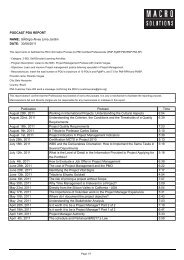urgency: a critical factor in project planning - Ricardo Vargas
urgency: a critical factor in project planning - Ricardo Vargas
urgency: a critical factor in project planning - Ricardo Vargas
Create successful ePaper yourself
Turn your PDF publications into a flip-book with our unique Google optimized e-Paper software.
simplifications of agile models, such as parts of the dynamics model for the<br />
collection and exchange of <strong>in</strong>formation taken at meet<strong>in</strong>gs of Daily Scrum of the<br />
Scrum model, for example (SCHWABER, 2010). It is important to emphasize that<br />
the goal of the process is the collection of <strong>in</strong>formation and not decision mak<strong>in</strong>g.<br />
2. Update WBS –The objective of this process is to update the Work Breakdown<br />
Structure (WBS) so that it cont<strong>in</strong>ues to reflect all deliveries made <strong>in</strong> the cycle. The<br />
rema<strong>in</strong><strong>in</strong>g work should be evaluated, and the draw<strong>in</strong>g of future deliveries should<br />
be performed if necessary. We must pay important attention to the difference<br />
between detail<strong>in</strong>g future deliveries and creat<strong>in</strong>g new deliveries. The creation of<br />
new deliveries that are not expected is a classic case of a sprawl of scope<br />
(scope creep) (KUPRENAS & NASR, 2003).<br />
3. Update Schedule – Process that aims to identify the work already done and their<br />
deadl<strong>in</strong>es, as well as updates on the WBS, seek<strong>in</strong>g to update the schedule and<br />
determ<strong>in</strong>e the <strong>project</strong> deadl<strong>in</strong>e. The new tim<strong>in</strong>g and deadl<strong>in</strong>e will be compared<br />
with the approved schedule (basel<strong>in</strong>e) to assess the performance of the <strong>project</strong>.<br />
4. Update Budget – The objective of this process is to assess the outlay for carry<strong>in</strong>g<br />
out the work cycle and update the rema<strong>in</strong><strong>in</strong>g budget. The new budget will be<br />
compared with the approved budget (basel<strong>in</strong>e) to evaluate the performance of<br />
the <strong>project</strong>.<br />
5. Revise Responsibility Assignment Matrix and Communication Plan – The<br />
objective of this process is to update the Responsibility Assignment Matrix and<br />
Communication Plan. Dur<strong>in</strong>g the implementation of the <strong>project</strong> changes beyond<br />
the responsibilities <strong>in</strong>herent to the <strong>project</strong>, there are often roles exchang<strong>in</strong>g and<br />
ref<strong>in</strong>ements <strong>in</strong> responsibilities, that causes changes <strong>in</strong> the Responsibility Matrix.<br />
The communication results are evaluated <strong>in</strong> this process to check if any element<br />
of communication needs to be created, deleted or amended <strong>in</strong> accordance with<br />
the behavior of the stakeholders. It aims to ensure that only valid <strong>in</strong>formation that<br />
supports the decision and the need for <strong>in</strong>formation will be produced, avoid<strong>in</strong>g<br />
unnecessary stress on the production of useless <strong>in</strong>formation.<br />
6. Update Risk Plan and Risk Response Plan – The objective of this process is to<br />
update the Risk Plan by identify<strong>in</strong>g new risks and review<strong>in</strong>g the already identified<br />
risks. The status of exist<strong>in</strong>g action plans and the evaluation of their effectiveness<br />
are also performed <strong>in</strong> this process.<br />
7. Develop Project Status Report – The objective of this process is to consolidate all<br />
executive <strong>in</strong>formation <strong>in</strong> a simple and straightforward report. The target audience<br />
of the report is def<strong>in</strong>ed <strong>in</strong> the Communication Plan and its contents present<br />
summary <strong>in</strong>formation about the performance of the <strong>project</strong> cycle and<br />
recommendations for change.<br />
8. Hold Change Control Meet<strong>in</strong>g – The objective of this process is to communicate<br />
the status of the <strong>project</strong> cycle, analyze the proposed change requests and<br />
decide on their <strong>in</strong>corporation (or not) to the <strong>project</strong>s.<br />
9. Implement Approved Changes – Process that aims to <strong>in</strong>corporate the approved<br />
changes to the <strong>project</strong> plan, <strong>in</strong>clud<strong>in</strong>g quick review of the documents already<br />
developed and appropriated communications about the implemented changes<br />
to the stakeholders.<br />
10. Document Lessons Learned – Process that aims to consolidate the lessons<br />
learned collected dur<strong>in</strong>g the last cycle of the <strong>project</strong>. The lessons conta<strong>in</strong> the<br />
record of positive experiences, such as improvements <strong>in</strong> processes and good





